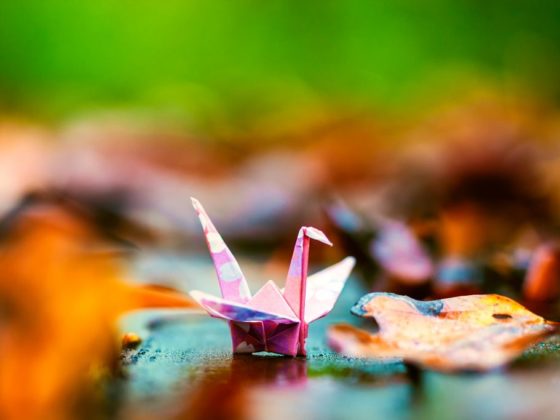I folded my first origami crane out of sandwich paper, during the middle of my lunch hour. There wasn’t anything special about it. No random inspiration or call from on high. Just a little bit of boredom, some crumpled paper, and a quick Google search for something interesting to do with it. In my remaining forty minutes off the clock, I managed to transform that crumpled wrapper into something resembling a crane.


Amused and proud that I’d managed to engineer this marvel, I left my creation on the table when I left the break room — a crime worthy of harsh reprimand and additional TPS reports, as anyone utilizing a shared office space will understand. I figured someone would find it amusing before throwing it out. Four hours later, I walked back to the break room to find that crane exactly where I left it. My coworkers had picked it up, examined it, and put it back where they found it.
That’s when I knew I was on to something.
I’ve heard origami — the centuries-old Japanese art form — described as poetry in three dimensions. For truly beautiful designs, I agree with that statement. Some designs carry a beautiful simplicity. Others are complex and robust, with the level of detail that you might expect from any masterwork. But my personal definition of paper folding is vastly different. To me, origami isn’t poetry.
It’s alchemy.
It’s the ability to transform paper into something greater than the sum of its parts. From snails to sea dragons, you’ll find a host of designs in the origami world. All of them require only two things: paper and time. Spatial understanding and more advanced techniques come with practice, patience, and a willingness to fail and try again.
Origami wasn’t a landslide hobby that consumed my life immediately. I wasn’t hooked to it on my first try. Instead, I danced around it. Little cranes, penguins, crows, and parrots decorated my workspace. I folded geometric, modular constructions out of sticky notes to keep my hands busy while I puzzled through daily assignments and dry-as-bones office meetings. At home, I attempted slightly more advanced models here and there, but I didn’t really know where to start with this hobby.
I was, for all practical purposes, alone in this venture.
A late-night Internet research expedition brought me to the first origami book purchase I ever made: Genuine Origami by Jun Maekawa. An origamist of no small renown, Maekawa’s models are almost purely mathematical. You’ll find some designers who take creative liberties with how to crease paper, but Maekawa’s models follow a progressive, consistent logic that make the instructions easy. For an absolute beginner still struggling to read diagrams, it was the foothold I needed to sink my teeth into paper folding.
Over the next several months, I transformed origami from a passing interest to an on-again, off-again hobby. I started to learn the tricks behind more advanced folds and how to read diagrams. Most interestingly, I learned that origami designers — like other artists — have particular styles and preferences that set their designs apart. By folding their models, I felt like I was getting to know the artist through their work.
My search for knowledge (and free, interesting models) expanded from books to YouTube. I began to interface with a community of video resources so that I could study more troublesome folds in real time. Sometimes, all the spatial understanding in the world won’t help you intuit how a fold is done. As my experience grew and my folds became more advanced, I found myself more closely integrated with artists and designers I’d never met, and likely never will.
Origami is a Japanese art, but it’s a global community. Diagrams are mostly standardized, so you don’t necessarily need an additional language to share your designs with someone. I fold models from Spanish, Japanese, and Vietnamese designers all the time, sidestepping the language barrier for diagrams. These aren’t individuals who I could communicate with if we were sitting across from one another. Instead, we share a language through folded paper.
As I’ve grown more advanced with origami, my interest in the hobby has deepened. I know the major players, both new and old, and the history of origami. I have specific designers and model types that I prefer. I can go on and on about specific paper types, and what paper or folding technique is best for what type of model. If I see any of the more common models that folders enjoy these days, I can probably cite the name of the model and the designer.
But, even years later, I’m still the only origamist I know.
That also means I’m the only origamist that most people in my social circle know. In many ways, that individualizes my hobby and gives me an opportunity to share something that’s wholly unique. I’m the origami guy. Nobody else does it, so it’s a good icebreaking topic that I can count on when meeting new people or renewing relationships with old acquaintances.
These days, my greatest connection to the community at large comes from giving away what I fold. My Christmas holiday gifts are all handmade creations, folded from specialty paper for each individual on my list. They’re personal and specific, and they’re a way for me to connect with the world around me through a community of folders I’ve never even met.
I’ve lost touch and reconnected with friends years later to find that they still have origami sitting in their car or on their bookshelf. To me, that speaks more to the value of origami than the state of a passing friendship. There’s something special about folded paper that entices people to keep it around.
For me, it’s community. For them, it’s alchemy.